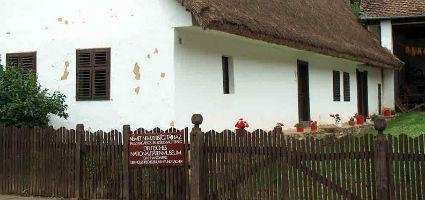2024. April 26. Friday
German Region House - Hidas
 |
Address: 7696, Hidas Kossuth Lajos utca 38.
Phone number: (72) 463-204
Opening hours: Tue-Sun 10-12, 15-17: on prior notice
(the key is at Mrs. Heim, 40 Kossuth Lajos Street) |
The village of Ófalu (Old Village) was repopulated by settlers arriving from Hessen and Fulda, beginning in the 1750s. The residents of Ófalu were originally tax paying cottars and serfs who were involved in forest related jobs in addition to keeping cattle.
The village of Ófalu is known for turned chairs the tradition of which came from neighbouring villages such as Bátaapáti, Zsibrik and Meszesvölgy (Kalktal). The spreading of the trade was due to abundance of wood from forests taking up large territory in the region, as well as a number of lakes rich in typha. After collecting raw material during summer, the families in the village were involved in making reed-mace and wood. The ready-made chairs were then transported over the neighbouring villages on foot or on carriages. Some of them were sold at fairs in Baranya County, Tolna County or Bácska.
Woodturning in the village was initiated by the Pausch family who relocated in the village in 1919 from Kisdorog. They mainly produced veranda pillars, cradles, beds, racks, looms and towel holders. Wood turners and chair-makers still work in the village today.
The Village House of Ófalu first opened in October 1979 with showings of wood turner and chair maker products from the village. The building hosting the showing was built by the Hahn family in the 1930s. The barn and the equerry were built in the 1920s.
The room is mainly furnished by furniture from around the turn of the century. Sofas made in the traditional style with some modern strait are to be seen in the backrooms. Farming tools, turning-lathes and hand tools are displayed in the equerry.
The roof of the Village House was hit by lightening on 7 August 1999 and burned down completely. Nearly everybody in the village participated in saving the exhibition material from the house. Everything, without exception, was saved, due to the cooperation of the villagers. The Village house was rebuilt, financed by many. Employees of the Ófalu Self-government and the Janus Pannonius Museum recovered the showing which reopened in a year's time. It has become one of the most popular village exhibitions in the county.
Mrs. Lantos, Mária Imre
The village of Ófalu is known for turned chairs the tradition of which came from neighbouring villages such as Bátaapáti, Zsibrik and Meszesvölgy (Kalktal). The spreading of the trade was due to abundance of wood from forests taking up large territory in the region, as well as a number of lakes rich in typha. After collecting raw material during summer, the families in the village were involved in making reed-mace and wood. The ready-made chairs were then transported over the neighbouring villages on foot or on carriages. Some of them were sold at fairs in Baranya County, Tolna County or Bácska.
Woodturning in the village was initiated by the Pausch family who relocated in the village in 1919 from Kisdorog. They mainly produced veranda pillars, cradles, beds, racks, looms and towel holders. Wood turners and chair-makers still work in the village today.
The Village House of Ófalu first opened in October 1979 with showings of wood turner and chair maker products from the village. The building hosting the showing was built by the Hahn family in the 1930s. The barn and the equerry were built in the 1920s.
The room is mainly furnished by furniture from around the turn of the century. Sofas made in the traditional style with some modern strait are to be seen in the backrooms. Farming tools, turning-lathes and hand tools are displayed in the equerry.
The roof of the Village House was hit by lightening on 7 August 1999 and burned down completely. Nearly everybody in the village participated in saving the exhibition material from the house. Everything, without exception, was saved, due to the cooperation of the villagers. The Village house was rebuilt, financed by many. Employees of the Ófalu Self-government and the Janus Pannonius Museum recovered the showing which reopened in a year's time. It has become one of the most popular village exhibitions in the county.
Mrs. Lantos, Mária Imre
|
Permanent exhibitions
|
|